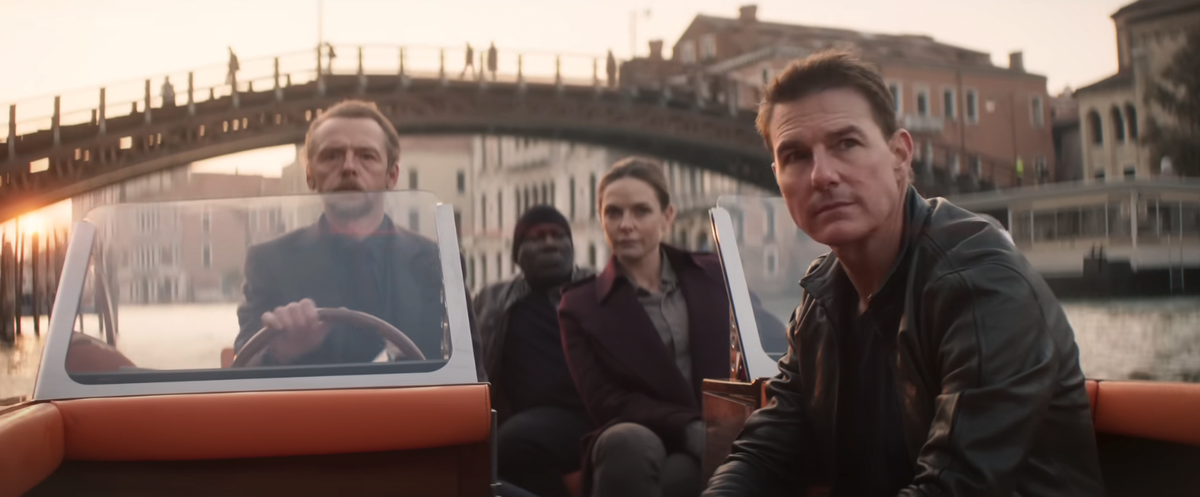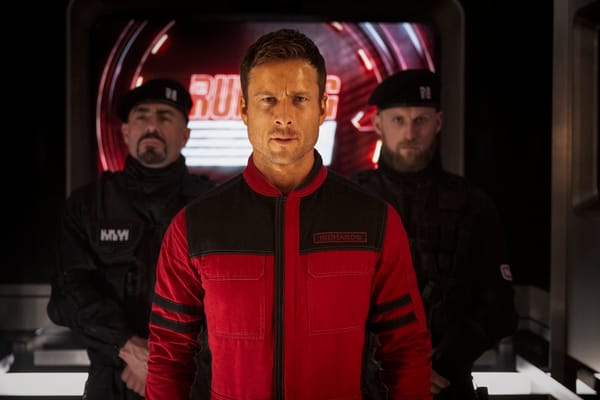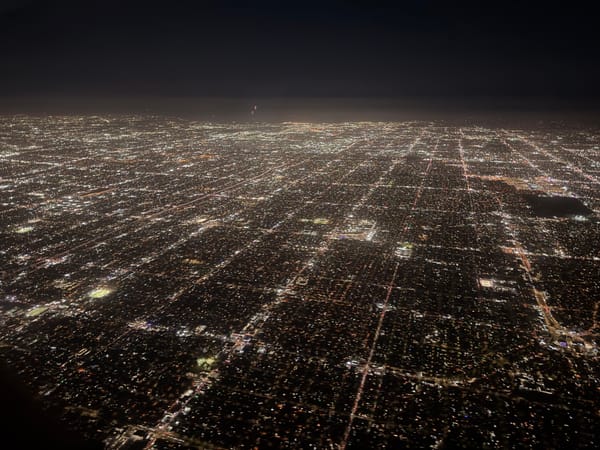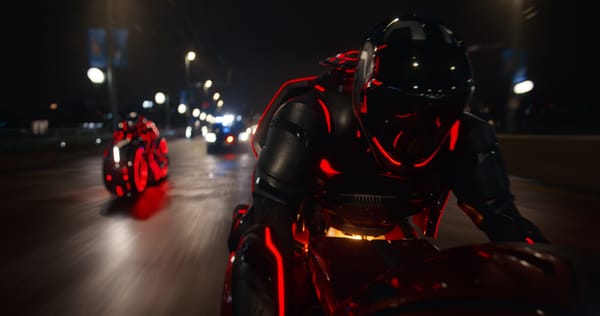'Mission: Impossible – Dead Reckoning' Shows The Limits of Improvising a Blockbuster
I wanted to love it.

[This post will contain virtually no plot details for the new Mission: Impossible movie.]
Mission: Impossible – Dead Reckoning Part One (henceforth Dead Reckoning) is not a bad movie. It’s actually hugely enjoyable for vast stretches at a time. Tom Cruise is one of few movie stars working today who will stop at nothing in the furtherance of his craft. He will hang off planes and jump off skyscrapers and ride his motorcycle off cliffs because he understands the audience wants to see something real when they head to the theater and if it takes a billionaire Scientologist actor jeopardizing his own life to give you that, then so be it. With writer/director Chris McQuarrie, he’s found the perfect collaborator — someone who understands precisely what Cruise brings to the table and is able to maximize its utility. McQuarrie knows how to set up stakes and make us empathize with his protagonists but he’s also able to marry that with what Cruise does best: extremely elaborate set pieces and stunts, amplified by Cruise’s charisma and star power, that push the limits of what’s possible in action filmmaking.
In Dead Reckoning, the results are occasionally breathtaking. Ethan Hunt and his IMF team continually get themselves into impossible jams, only to extricate themselves via the most visually entertaining means possible. And while the use of CG or stunt doubles is sometimes noticeable, you always get the sense that somebody did something incredibly challenging to bring each scene to life, unlike so many other blockbusters that have been released recently (*ahem* and *ahem*). To quote my colleague Stephen Tobolowsky, “There’s blood in the work.” In terms of sheer spectacle, Dead Reckoning is one of the best action films of the year.
And yet.
My thoughts on Dead Reckoning are a bit complicated and to go into it, I need to talk about the last film in the franchise, Mission: Impossible - Fallout. Fallout is my favorite Mission: Impossible film. It had a propulsive plot that never made me feel bored. The way the film handled the character of Julia satisfyingly tied up an arc of Ethan’s that began with M:I-3. It had super simple stakes (stop 1/3rd of the world’s population from losing their water supply!). And of course, it had the stunts.
After seeing the film in an IMAX theater, I became obsessed, listening to hours and hours of McQuarrie’s interviews about it and eventually seeing it in theaters five times (and countless more at home). One thing that stuck with me was how improbable it was that McQuarrie was able to stitch the entire thing together in a seamless way. McQuarrie was very upfront about structuring his movie around huge, ambitious set pieces, then figuring out a way to fill in the interstitial pieces of plot and character after the fact. His interview with Slate from 2018 provides a characteristic description of this (and inspired the title of this piece):
[McQuarrie:] We find ourselves in creative meetings all the time with my team looking at me and saying, “What are we gonna do when we get to New Zealand?” And I said, “I’m working on it. Just give me the set and I’ll know what to do on the set when I get there. First, show me where I’m shooting and I’ll tell you what’s gonna happen when we get there.”
[Interviewer:] A movie going into production without a completed script is usually reported as a sign that a movie is in trouble, but it seems that the more experienced you are at making these kinds of movies, the more that’s the way you work.
It is, and it’s never by choice. I would much rather have a script going in and have that plan and not have to spend my weekends staring at a blank screen and trying to figure out what the movie’s going to be. But what I’ve learned over the course of working on three of these movies is that if the major pieces are in place, you can keep the train moving without actually knowing what’s going to be said in the locations before you get there. As long as everybody knows, “OK, this is where we’re going to be shooting on this day, and this is roughly what we’re going to be shooting.” The information, the story, that’s being conveyed on top of that is malleable. So a lot of times we’ll shoot scenes out of order and those scenes will tell us what the scenes around them need to include in order for the scene you just shot to make sense. You start with an infinite number of possibilities, and with everything you commit to film, your possibilities are reduced. The boundaries are created and the infinite possibilities for where the story [is] going become immediately finite. And your choices are made for you by the end of the film.
When that approach works, it can feel like a miracle; in Fallout, it certainly does. At no point am I questioning the purpose of a scene or a character’s motivation.
But what happens when this approach collides with a global pandemic?
The real impossible mission was finishing the movie
It’s amazing that any movie gets made but that goes double for Dead Reckoning, which, with a $290 million budget, is one of the most expensive movies ever. A lot of that cost is due to multiple shutdowns that were required due to COVID outbreaks. In The Hollywood Reporter in March 2022, Kim Masters detailed the nightmarish sequence of events that threatened to derail the film:
M:I 7 became one of the first major productions to run headlong into the pandemic. On Feb. 24, 2020, just days before filming was to begin in Venice, Paramount announced that it was shutting down the production “out of an abundance of caution.” According to a source, Cruise was then still in London, stricken with an illness that was not believed to be COVID-19. The production moved to Rome, only to stop again March 9, when the Italian government locked down the country. Cast and crew resumed work in July after British authorities gave the production special dispensation to skip a mandatory 14-day quarantine. After Cruise called the country’s minister of culture, Norway also gave permission to shoot without observing the country’s 10-day quarantine requirement. (The British tabloid The Sun reported that Cruise paid $676,000 for a cruise ship so cast and crew could isolate.) Back in Italy in October 2020, the film shut down for a third time after a dozen people on set tested positive for the coronavirus. According to a source, one of Cruise’s security guards had a gathering in his hotel room that also led to some cases. The production moved to Venice, only to be shut down for the fourth time because of positive tests.
For a film that had an airtight script, it would’ve been difficult to contain the impact of such production issues. But for a movie where, as the article states, “Cruise and McQuarrie decided to add a submarine to [Dead Reckoning] after the film was supposed to have been wrapped,” my guess is it was likely impossible.
Indeed, Dead Reckoning bears the hallmarks of a film that had a suboptimal production process. While I love the main themes (made surprisingly relevant by recent real-world developments), there is a lot of ponderous exposition. It simultaneously feels like characters are providing too much explanation, but also not enough. The villain(s’) capabilities and motivations are thin or ill-defined. Beloved characters drift into the world without much fanfare, then leave just as abruptly. A shockingly large number of new characters are introduced, whereas characters from previous films feel poorly served.
The entire thing has an episodic feel, like each section was made on its own and then clunkily pieced together with rough interstitials in post. On occasion, I found myself feeling something I haven’t felt during a Mission: Impossible film in many years: restless.
To the film’s credit, it feels the most complete out of all the part 1 movies we’ve seen this summer. Yes, there are plot threads to resolve, but Dead Reckoning still feels like a whole idea with a definitive ending and a firm promise for more fun down the line. I still think Dead Reckoning is a good time at the theater but I was hoping for a transformative experience on par with (or at least within spitting distance of) Fallout. Instead, I thought it was pretty decent.
Despite all that, what is undeniable is Tom Cruise’s commitment. This is the will of a man who will not let the art of blockbuster filmmaking go quietly into the night. He recently said in an interview that he hopes to keep making Mission: Impossible films until he’s 80. If he does, I’ll still buy a ticket for every one of them on opening night.
Thanks for reading Decoding Everything! Please consider subscribing to support me.
My Current Mission: Impossible Movie Rankings
- Mission: Impossible - Fallout
- M:I 1
- Mission: Impossible - Ghost Protocol
- Mission: Impossible - Rogue Nation
- Mission: Impossible - Dead Reckoning Part 1
- M:I 3
- M:I 2
Other Stuff David Chen Has Made
- If you enjoy my work, please consider becoming a Patron. Over on my Patreon page, you can hear me and @joyonapping discussing our complicated thoughts about Dead Reckoning right after we left our first screening of it.
- Remember how last week I was on The Next Picture Show to discuss Once? I returned this week to discuss Past Lives. Listen here! (and check out my full spoiler-review with Brooke Obie too).
- On The Filmcast, we reviewed Joy Ride, a fun movie with a surprising amount of heart.
- Hey, did you know I host a podcast called Decoding TV? We’ll be announcing some cool coverage of upcoming TV shows this week so be sure to subscribe and stay tuned!
- On Instagram, millions of people tuned in to hear me discuss whether or not I’m going to be watching Barbie or Oppenheimer first.



